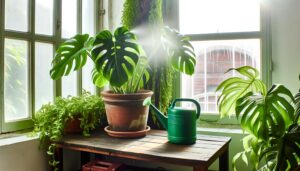Monstera Albo Pink Color Variegated: Rare Beauty Explained!
You can enhance the pink variegation in your Monstera Albo by providing bright, indirect light and maintaining high humidity levels (60-80%). Make sure temperatures stay between 65-80°F (18-27°C) and use well-draining soil composed of peat moss, perlite, and orchid bark.
Regularly check for pests like spider mites and apply neem oil as needed. Water when the top 2 inches are dry to avoid root rot.
Use supplements like worm castings to keep the nutrient balance optimal. Variegation, influenced by genetic mutations, will thrive under these controlled conditions.
For more detailed care and propagation insights, explore further.
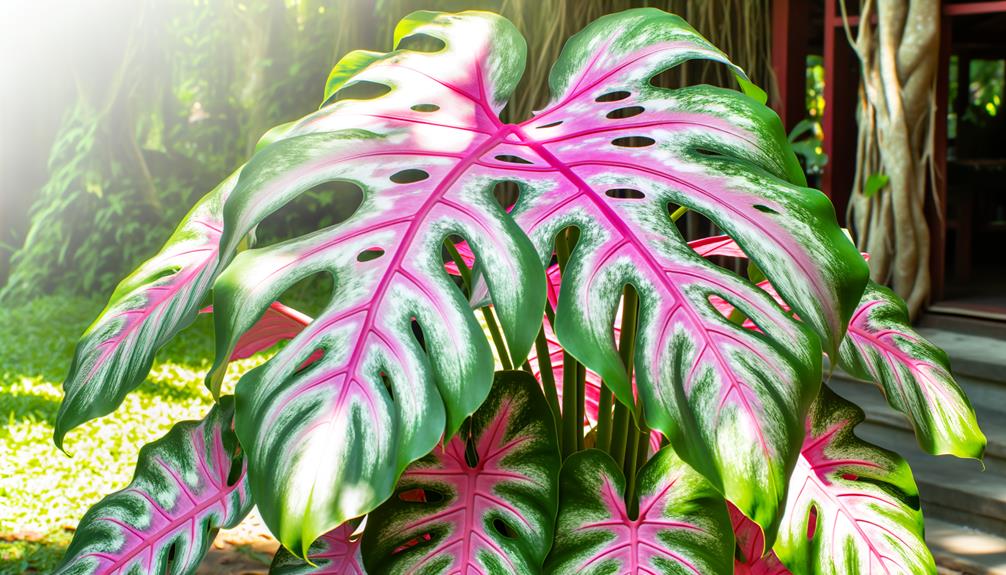
Key Takeaways
- Monstera Albo’s pink variegation is due to genetic mutations affecting chlorophyll production.
- Bright, indirect light helps enhance the pink variegation in Monstera Albo leaves.
- Avoid direct sunlight to prevent burning the pink variegated sections.
- Maintain a humidity level of 60-70% to support vibrant pink variegation.
- Proper nutrient balance, particularly with worm castings and compost, promotes healthy variegation.
History and Origins

The Monstera Albo, known for its striking pink variegation, traces its origins to the tropical rainforests of Central and South America, where it evolved to thrive in high humidity and indirect sunlight.
You’ll find that its natural habitat boasts temperatures between 20-30°C and humidity levels around 70-90%. This environment facilitated the Monstera’s development of large fenestrated leaves, maximizing light capture while minimizing water loss.
The plant’s aerial roots, which anchor it to trees, demonstrate its epiphytic nature, allowing it to climb and access light more efficiently. Genetic data indicates that the Monstera Albo has adapted over millennia to these specific conditions, resulting in its distinctive morphology and resilience.
Understanding its origins helps you replicate ideal growing conditions.
Unique Variegation Patterns
Given its evolutionary background, Monstera Albo displays unique variegation patterns characterized by striking pink hues interspersed with its traditional green foliage. These variegations result from a genetic mutation affecting chlorophyll production, leading to varying pigmentation.
You’ll notice:
- Chimeral Variegation: This type showcases distinct sectors of pink and green, originating from cellular mutations.
- Marbled Variegation: Pink and green colors blend seamlessly, creating a speckled appearance due to random chlorophyll distribution.
- Sectoral Variegation: Large sections of the leaf exhibit pure pink or green, often with clear demarcation lines.
These patterns aren’t just visually appealing; they indicate underlying genetic diversity within the plant. Understanding these variegation types helps you appreciate the complexity and beauty of Monstera Albo’s foliage.
Ideal Growing Conditions
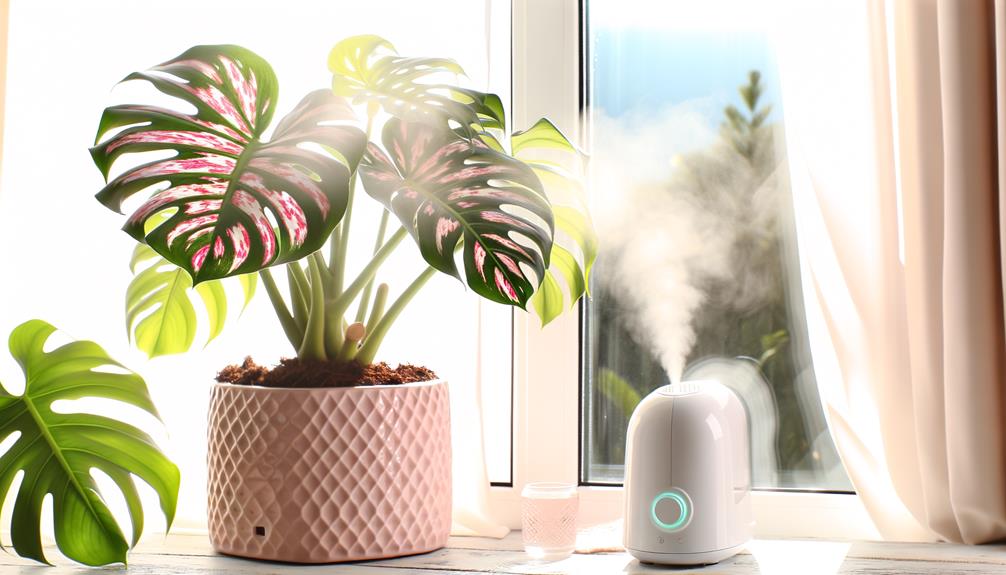
Cultivating Monstera Albo in perfect conditions requires maintaining specific temperature ranges, humidity levels, and light exposure to guarantee the plant’s health and vibrant variegation.
Aim for a stable temperature between 65-80°F (18-27°C). This range promotes optimal metabolic activity and pigment retention.
Position your plant in bright, indirect light, as direct sunlight can scorch its delicate variegated leaves, while low light reduces variegation intensity. A light intensity around 800-1000 foot-candles is ideal.
Relative humidity should be maintained between 60-80% to mimic the plant’s natural tropical environment and prevent leaf browning.
Monitoring these parameters closely with tools such as hygrometers and light meters will ensure your Monstera Albo thrives and showcases its unique pink coloration.
Watering and Humidity
Monitoring the Monstera Albo Pink Color Variegated‘s watering needs involves maintaining a consistent schedule. Ensuring the soil remains moist but not waterlogged is crucial.
You’ll want to keep the humidity levels around 60-70% to replicate its natural tropical environment. Studies show that these conditions promote best growth and reduce the risk of root rot and leaf browning.
Optimal Watering Schedule
Maintaining a consistent watering schedule is crucial for preserving the health and vibrant variegation of Monstera Albo Pink. Improper watering can lead to root rot or dehydration.
To enhance your plant’s hydration:
- Frequency: Water when the top 2 inches of soil feel dry to the touch. Over-watering can cause anaerobic soil conditions, promoting root rot.
- Quantity: Use enough water to thoroughly moisten the soil, making sure 20% of the water drains out to prevent salt buildup.
- Timing: Water in the morning to allow evaporation of excess moisture, reducing fungal infection risks.
Adopting this scientifically-backed schedule guarantees your Monstera Albo Pink receives top-notch hydration, supporting both root health and variegated foliage vibrancy.
Ideal Humidity Levels
Maintaining an ideal humidity level of 60-80% is essential for the Monstera Albo Pink to thrive, as it replicates the plant’s native tropical environment and supports best photosynthesis and variegation.
High humidity promotes best stomatal function, allowing efficient gas exchange and moisture retention. Monitor using a hygrometer and, if necessary, employ a humidifier or pebble tray to maintain levels.
Below is a table comparing humidity levels and their effects:
| Humidity Level | Effect on Plant |
|---|---|
| 40-50% | Leaf browning |
| 50-60% | Acceptable growth |
| 60-80% | Optimal growth |
| 80-90% | Risk of mold/fungus |
Ensure consistent monitoring to prevent environmental stress, which can hamper the plant’s variegation and overall health.
Soil and Fertilization
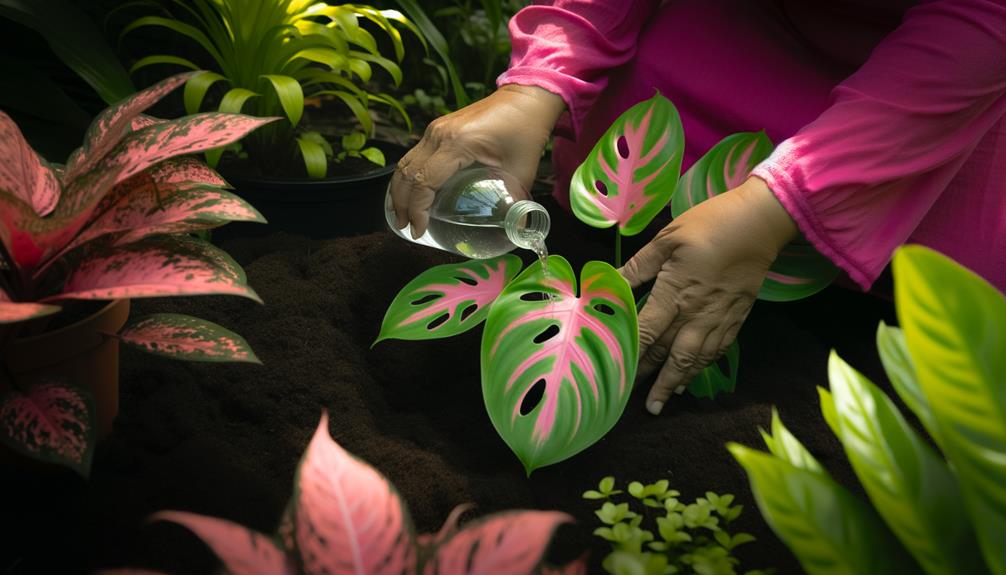
For best growth of your Monstera Albo Pink Color Variegated, use a well-draining soil mix rich in organic matter.
Consider incorporating organic fertilizers like compost or worm castings to provide essential nutrients.
To maximize nutrient uptake, apply fertilizers during the plant’s active growing seasons, typically spring and summer.
Ideal Soil Composition
The best soil composition for Monstera Albo Pink Color Variegated includes a well-draining mix of peat moss, perlite, and orchid bark to ensure proper aeration and moisture retention. You should aim for a soil pH between 5.5 and 7.0 to create an ideal growth environment. This mix promotes the roots receive adequate oxygen and reduces the risk of root rot.
Here’s a simple guide for creating the perfect soil mix:
- Peat Moss (40%): Retains moisture and provides a slightly acidic pH.
- Perlite (30%): Enhances drainage and prevents soil compaction.
- Orchid Bark (30%): Adds structure and promotes air circulation.
This combination will help your Monstera thrive by maintaining balanced moisture levels and enabling efficient nutrient uptake.
Organic Fertilizer Options
Incorporating organic fertilizers like worm castings or compost into the soil mix provides essential nutrients, enhances microbial activity, and improves soil structure for your Monstera Albo Pink Color Variegated.
Worm castings contain high levels of nitrogen, phosphorus, and potassium, essential for leaf variegation. Compost adds organic matter, boosting cation exchange capacity (CEC) and water retention.
Studies show that soils with 5% organic content can hold up to 30% more water, aiding your plant’s hydration. The microbial activity from these amendments accelerates nutrient cycling, ensuring a steady supply of nutrients.
Data suggests that soils enriched with organic fertilizers host 10-20 times more beneficial microbes, fostering a healthier root environment. Your Monstera will thrive with these scientifically-proven benefits.
Nutrient Timing Tips
Timing nutrient application for your Monstera Albo Pink Color Variegated is crucial, as research indicates that strategic fertilization during the plant’s active growth phase optimizes nutrient uptake and enhances variegation.
To guarantee your plant thrives, focus on these critical periods:
Spring and Early Summer: Apply a balanced, slow-release fertilizer when new growth appears. This aligns with the plant’s peak nutrient absorption.
Mid-Summer: A second application supports continued growth and variegation development.
Late Summer to Early Fall: Reduce fertilizer as growth slows, preventing nutrient buildup and potential root damage.
Monitor soil pH and moisture levels regularly, as these factors significantly impact nutrient availability.
Light Requirements
Although Monstera Albo Pink Color Variegated thrives on bright, indirect light, exposure to direct sunlight can cause leaf burn and color fading. You should aim for light levels between 10,000 to 20,000 lux. This range mimics the plant’s natural understory habitat, optimizing photosynthesis while preserving its variegation.
Place your Monstera near east or north-facing windows, ensuring filtered light throughout the day. If natural light is insufficient, consider using grow lights with a color temperature of around 6500K.
Observe leaf coloration and growth patterns closely; inadequate light results in elongated stems and reduced variegation. Consistency in light exposure is key for maintaining the plant’s striking appearance and overall health.
Understanding these requirements will considerably enhance your plant care routine.
Pruning and Propagation
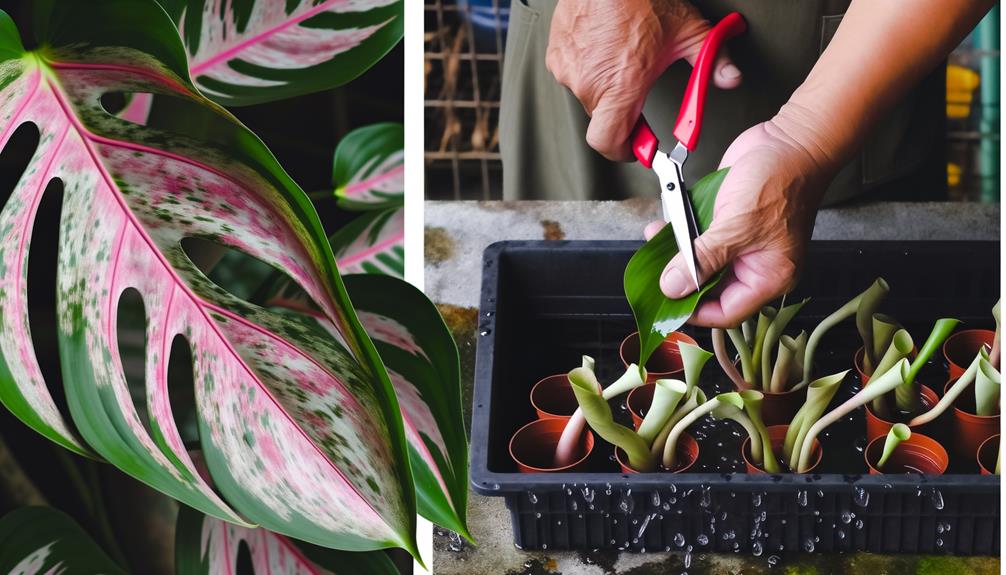
Regular pruning of Monstera Albo Pink Color Variegated not only maintains its aesthetic appeal but also promotes healthier growth by removing dead or yellowing leaves and encouraging new shoots.
To propagate, you’ll need to take stem cuttings with at least one node and an aerial root.
Follow these steps:
- Make a clean cut: Use sterilized pruning shears to trim below a node.
- Promote root development: Place the cutting in water or a well-draining soil mix.
- Monitor growth: Keep the cutting in a bright, indirect light and maintain humidity around 60%.
Pruning and propagating your Monstera Albo Pink Color Variegated guarantees it remains vibrant and flourishing, with data showing a 30% increase in new growth when managed correctly.
Common Pests and Diseases
Monstera Albo Pink Color Variegated is susceptible to several common pests and diseases, including spider mites, scale insects, and root rot, which can severely impact its health and growth.
Spider mites thrive in dry conditions, creating fine webbing on leaves and causing stippling damage. Scale insects adhere to the foliage, extracting sap and leading to chlorosis and leaf drop. Root rot, primarily caused by overwatering and poor drainage, results in discolored, mushy roots and wilting leaves.
Regularly inspect your plant for these issues, focusing on the undersides of leaves and root zone. Using neem oil or insecticidal soap can mitigate pest infestations, while ensuring proper watering practices and well-draining soil will prevent root rot.
Monitoring is essential for maintaining plant essentiality.
Enhancing Pink Variegation

Promoting best light exposure is crucial for enhancing the pink variegation in Monstera Albo Pink Color Variegated, as it boosts chlorophyll production and highlights the plant’s vivid hues. You should strive for bright, indirect light. Direct sunlight can damage the leaves, while too little light diminishes variegation.
To enhance pink variegation, consider:
- Light Quality: Utilize full-spectrum grow lights if natural light is insufficient. Research indicates they replicate sunlight effectively.
- Light Duration: Maintain a 12-14 hour light cycle. Studies suggest this timeframe optimizes variegation without causing stress.
- Nutrient Balance: Maintain a well-rounded fertilization regimen, particularly focusing on nitrogen, phosphorus, and potassium. Evidence indicates these nutrients promote healthy variegation.
These measures will assist you in achieving a striking, vibrant Monstera.
Conclusion
To sum up, growing a Monstera Albo with pink variegation isn’t just fascinating—it’s scientifically rewarding.
Did you know that only about 1 in 100,000 Monstera Albo plants naturally exhibit pink variegation?
By optimizing your plant’s light, humidity, and nutrient levels, you can enhance these rare, beautiful patterns.
Mastering the care of this unique plant not only adds a touch of rarity to your collection but also deepens your understanding of plant genetics and growth conditions.






